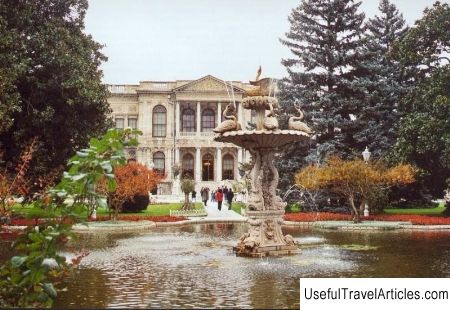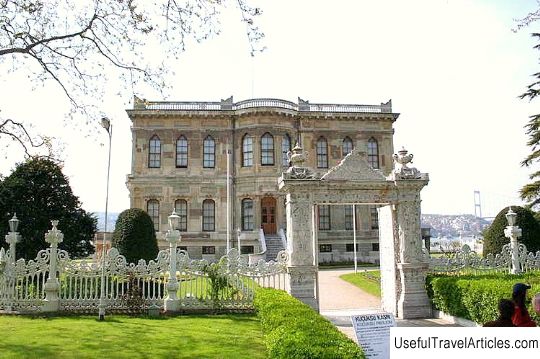Dolmabahce Palace description and photos - Turkey: Istanbul
Rating: 8,5/10 (1389 votes) 
Dolmabahce Palace description and photos - Turkey: Istanbul. Detailed information about the attraction. Description, photographs and a map showing the nearest significant objects. The name in English is Dolmabahce Palace. Photo and descriptionDolmabahce Palace is the last sultan's palace in Istanbul. Translated from Turkish "Dolmabahce" means "bulk garden". The palace was built on the site of a small covered bay. Initially, at the beginning of the 17th century, a wooden structure Besiktas was built. In the middle of the 19th century, this building was replaced by the Dolmabahce Palace, which was built in the European style. In 1853, Sultan Abdul-Majida the First ordered the construction of such a magnificent palace, which cannot be compared with the palaces of European monarchs. The construction of the Dolmabahce palace complex was carried out by the architects Karapet and Nikogos Balyanomami. Dolmabahce Palace is a massive neoclassical three-story building with a white marble facade. The length of the facade of the palace is 600 m.The interior of the palace is rich: ceilings and walls are decorated with gold, antique French furniture, a huge collection of clocks, vases, candlesticks, paintings, Bohemian crystal, silk carpets, white marble bath. The palace complex includes several buildings. The palace kitchens are located separately from the building on the other side of the road. The kitchens were specially placed separately from the castle so that the smells of cooking food would not disturb the residents of the castle. A pier was built for guests arriving by sea. The Dolmabahce palace complex has 12 gates. Currently, there is a guard of honor at some gates. The changing of the guard is considered a special ceremony. There are many rooms in the palace that have different purposes: harem - female part; the male half, in which the Sultan's apartments are located; library; hall for receptions. The largest room is the reception hall, the dome of this room is decorated with a large crystal chandelier weighing 4.5 tons. This chandelier was a gift from Queen Victoria. There is also a gift from Russia in the palace - the skin of a polar bear. To prevent the skin from getting dirty, the Turks repainted it brown. Some rooms of the palace are decorated with paintings by the famous artist Aivazovsky. At the end of the 60s. 19th century Ottoman Sultan Abdul-Aziz ordered about 40 paintings depicting the Bosphorus. For the execution of this order, the artist received the highest Turkish award - the Order of Osman, decorated with diamonds. But after several years, Aivazovsky threw the order into the sea, which meant a protest against the massacre that the sultan staged in 1894-1896. All clocks in the palace are stopped and the time is set to 09:05. This is the time of the death of the founder of the Turkish Republic - Mustafa Kemal Ataturk. He died in this palace, which was his residence, on November 10, 1938. The room in which Kemal died is preserved in the form in which it was in the last minutes of the life of the first president of Turkey. Kemal's bed is covered with the national flag. Today, the palace has been restored and is open to the public. The precious things of the palace are exhibited in two halls (Salon of Precious Things). It houses a collection of national porcelain, as well as the "Treasury of the Palace", which includes priceless paintings. Exhibitions of paintings are held in the Gallery Hall. The room in which photographs are exhibited is located under the "Gallery Room". The library of Sultan Abdulmejit can be accessed by walking along the corridor from the "Gallery Hall". In the garden there is a room for storing home textiles, a children's room, a clock tower. There is a cafeteria and a souvenir shop for visitors. Here tourists can buy educational books, miniatures of paintings made from art collections, postcards with views of palaces.       We also recommend reading Franciscan monastery (Franjevacki samostan i crkva Male brace) description and photos - Croatia: Dubrovnik Topic: Dolmabahce Palace description and photos - Turkey: Istanbul. |




